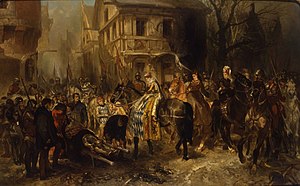| Hook and Cod wars | |||||||
|---|---|---|---|---|---|---|---|
 Jacqueline of Bavaria, entering the conquered Gorkum, faces the corpse of William, Lord of Arkel | |||||||
| |||||||
| Belligerents | |||||||
|
Hook alliance |
Cod alliance | ||||||
| Commanders and leaders | |||||||
| Margaret II | William I | ||||||
The Hook and Cod wars (Dutch: Hoekse en Kabeljauwse twisten; sometimes semi-anglicised as the wars of the Hoecks and the Cabbeljaws) comprise a series of wars and battles in the County of Holland between 1350 and 1490. Most of these wars were fought over who should hold the title of "Count of Holland". The Cod faction generally consisted of the more progressive cities of Holland. The Hook faction consisted for a large part of the conservative noblemen.
The origin of the name "Cod" remains uncertain, but is most likely a case of reappropriation. Perhaps it derives from the Bavarian coat of arms, which resemble the scales of a fish. The Hook refers to the hooked stick that is used to catch cod.
Another possible explanation of "Cod" points out that as a cod grows it tends to eat more, growing even bigger and eating even more, thus encapsulating how the noblemen perhaps saw the expanding middle classes of the time.